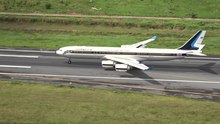Touch-and-go
Touch-and-go (German: put on and go ) is an English term in aviation language . It describes the flight maneuver of an aircraft with landing gear and subsequent go- around without stopping; the landing approach is thus canceled. The maneuver is for safety.
This procedure is also carried out on aircraft carriers in order to qualify pilots to operate on an aircraft carrier. Pilots who are stationed on an aircraft carrier must regularly show a certain number of day and night landings in order to be approved for flight operations. In the event of a touch-and-go on aircraft carriers, the catch hook remains up and thus cannot brake the aircraft using the catch rope as usual . An unplanned termination of the landing due to an unfavorable flight path or an unsafe runway is known as a bolter .
When supplies and supplies are dropped by transport aircraft, a touch-and-go can also be flown. The aircraft starts to land with the tailgate open. The load, which is attached to pallets, slides out of the loading area and can be brought to a standstill with the help of a braking parachute. In this way, the aircraft itself quickly sets down the cargo without landing and is only exposed to potential hazards for a short time. This maneuver, which can also be carried out without touching the runway, also makes it possible to fly to poorer or shorter runways for the launch.
Some fire-fighting aircraft use touch-and-go maneuvers over a body of water to quickly take in fire water.
The maneuver is largely standard in flight training .
